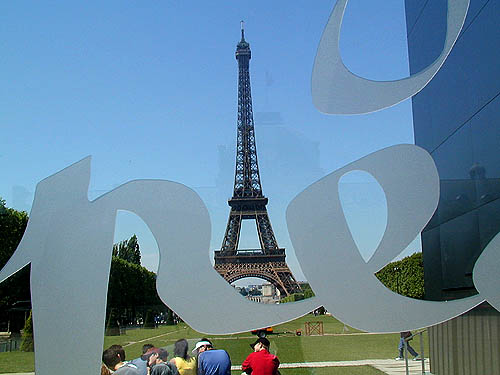

Thanks to the French stereotype, we were paranoid about our safety, prepared for mistreatment and rudeness, and predisposed to hostility as we considered traveling to Europe's most visited country. In fact, most accounts from friends and family had us convinced to bypass France completely. That would have been a HUGE MISTAKE! Fortunately, as mentioned on the Italy page, we had met Claire from Paris during our Italian language course. We had asked her then why the French don't like Americans. She said that French people, especially Parisians, don't like tourists in general for their often demanding and rude attitudes. We stayed in Paris with Claire and her family for ten days, and spent another week in the Loire Valley. There aren't enough superlatives to describe the people, places and pleasures we have experienced in this seemingly misunderstood country.
We stopped in Nancy overnight on our way to Paris. The government of this city was given to exiled King Stanislaus of Poland by his son-in-law King Louis XV. Stanislaus commissioned the palaces, parks and places (squares) that give the city a grand quality. Tiny streets, doted with brightly painted store fronts, carve through a charming old town. We enjoyed a superb three course lunch in an outdoor restaurant before leaving. Below: Pictures from Nancy
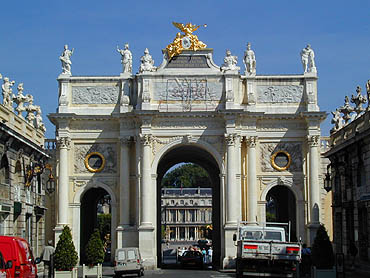
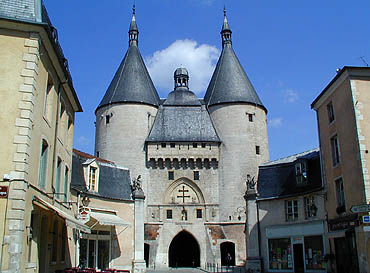
One stereotype we must agree with: Paris is the most beautiful city in the world! Baron Haussmann's large scale urban re-planning, carried out from 1852 to 1870, appears to have been the most influential catalyst for the city's evolution. The architect laid grand boulevards through the old quarters, designed new apartment houses alongside, completed many public building projects, including the Louvre, created a sufficient sewer system, and divided the city into 20 distinct areas. This project led to the integration of more brilliant architecture and to continued foresight in urban design. Skyscrapers have been banned to the outskirts of Paris, preserving the inner city's central symmetry. Such efforts and smart decisions have resulted in harmony and magnificence on a scale not elsewhere realized. Like the movement of a Rolex everything fits together and works flawlessly.
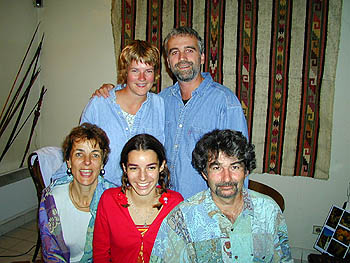 We thoroughly enjoyed staying with Claire, Gerard and their two children ten miles outside of Paris. Trains and buses brought us to the sights around town, a very pleasant way to see all of Paris. At the end of an exhausting touring day we would arrive at Claire's home, immediately take refuge in the shade of the garden, join the family for delicious meals and lively conversations. Claire and her family spoiled us with great food, wine, laughter and friendship. They showed us some of their favorite places in Paris, and helped us to organize our itineraries there and in the Loire Valley. We hope they will visit us soon, so we can reciprocate their generosity.
We thoroughly enjoyed staying with Claire, Gerard and their two children ten miles outside of Paris. Trains and buses brought us to the sights around town, a very pleasant way to see all of Paris. At the end of an exhausting touring day we would arrive at Claire's home, immediately take refuge in the shade of the garden, join the family for delicious meals and lively conversations. Claire and her family spoiled us with great food, wine, laughter and friendship. They showed us some of their favorite places in Paris, and helped us to organize our itineraries there and in the Loire Valley. We hope they will visit us soon, so we can reciprocate their generosity.
We spent two half days in the Louvre. Inside the largest museum in the world, hundreds of rooms contain an astounding collection of famous artwork. The layout of the vast spaces sometimes became confusing and tiring. Some of the most famous paintings, like da Vinci's Mona Lisa, are poorly exhibited. Opposite paintings are reflected on the glass; the lack of space causes overfilled walls, with many paintings hanging high above eye level. We found the Musee d'Orsay a much more intimate and pleasant arrangement. This museum contains the most complete impressionist art collection in the world.
We welcomed the opportunity to secure the last two tickets to a concert at the Paris Opera House. In addition to the interior and exterior splendor of the building, we enjoyed excellent performances of Mendelsohn's A Mid Summer Night's Dream and Beethoven's 7th Symphony. The orchestra played three encores, finishing with bravos one of the finest concerts we ever heard. Our stair climb to the second level of the Eiffel Tower allowed us to fully appreciate the immensity and complexity of this famous landmark. Upon arrival, we were treated to breathtaking views over the city. The Church of Notre Dame is a grand example of gothic architecture, impressing most with an incredible facade and beautiful stained glass windows. However, the interior artwork is less significant than the paintings and sculptures we discovered in the smallest churches of Italy. A walk up the Champs Élysées from Place de la Concorde to the Arc de Triomphe provides a great opportunity to shop, people watch and enjoy the splendor of Paris' most famous thoroughfare.
We visited the grounds of Versailles on two different occasions. Once, to bike around the grand lake and park with Claire and Gerard, the second time to tour the palace. Interior furnishings are sparse as a result of the revolution's carnage. The rooms still showcase elaborate ceilings and walls decorated with gilded stucco, fine paintings, lamps and tapestries. The walls of the 246-feet-long Hall of Mirrors are covered with 578 mirror panels, reflecting the sunlight or thousands of candles in giant crystal chandeliers. The number of people allowed to enter at one time often detracted from our viewing pleasure. Still, this vast complex allows us to picture the life and times of egocentric kings and their indulgent courts, as well as appreciate the works of brilliant artists and architects. The days flew by as we visited other churches, museums, areas and famous buildings. The quantity of sites in Paris exceeds the capacity of one visit. We look forward to our next stay in this marvelous, vibrant, friendly city.
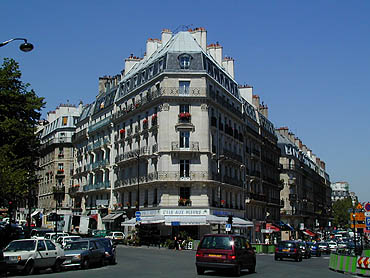
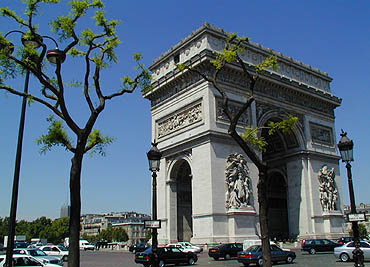
Above left: A typical Paris boulevard. Above right: Arc de Triomphe.
Below left: Paris Opera ceiling painted by Marc Chagall.
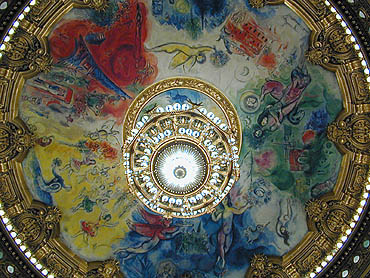

Above right: Paris Opera at night. Below left: Notre Dame. Below right:
The Louvre Museum.
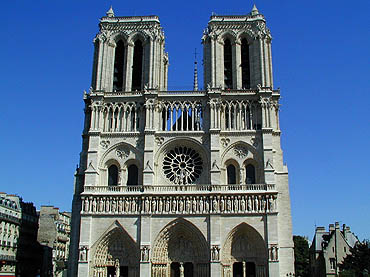
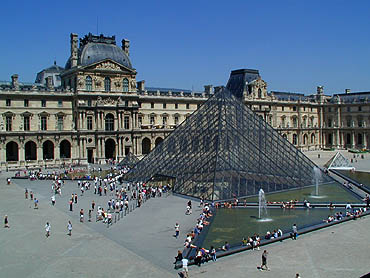
France courted us with the beauty of Paris, impressing us with its glamour
and sophistication. But our real love for this country occurred amongst
the gentle rolling hills, golden fields and fairy tale castles of the Loire
Valley. For self preservation, and as testament to their wealth and power,
kings and noblemen built grand fortifications, palaces and villas along
the rivers Loire and Cher. Some have fallen to ruin, but many still remain
to transport us back to the times of knights, chivalry and nobility. Our
visit to Chambord (below left), a huge castle commissioned by Francis I
upon his return from Italy, would initiate an unquenchable thirst for the
history of this period. The building's architectural style reflects the
king's desire to bring the Renaissance to France. 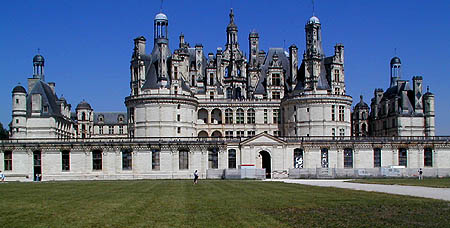 Historians suggest that the main spiral staircase may have been designed by Leonardo da Vinci who spent his last years nearby at Amboise. Like a strand of DNA, the staircase includes two separate spirals. This allows the passage of multiple people without ever meeting, although one can see the other pass looking through windows in the central column.
Historians suggest that the main spiral staircase may have been designed by Leonardo da Vinci who spent his last years nearby at Amboise. Like a strand of DNA, the staircase includes two separate spirals. This allows the passage of multiple people without ever meeting, although one can see the other pass looking through windows in the central column.
The palace at Cheverny remains in the possession of the original family. As a result it was saved from the ravages of the revolution and enjoys a complete and well preserved interior. Furnishings from the period of Louis XIV, famous Belgian tapestries still vibrant in color, paintings, musical instruments and more decorate the numerous rooms. The surrounding lawns our filled with rare trees, and manicured more precisely than a golf course. A pack of rare hunting dogs is maintained by the family for annual stag and bore hunts on the grounds of Chambord, Cheverny and at other locations. Chenonceau (below right) is the most visited, and perhaps the most beautiful of all the estates. It lies across the gentle River Cher, connecting its sides like a bridge, and creating mesmerizing reflections. 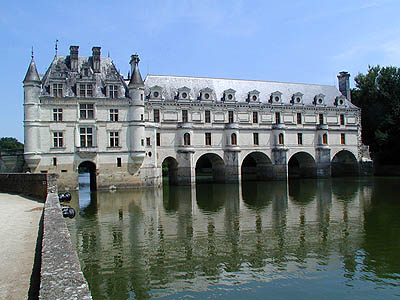 Two lovely gardens compliment each side of the entrance. On the shady patio of the orangerie, overlooking the splendid gardens, we indulged in a three course gourmet lunch with fine wine. Time melted away like ice-cream on a hot day.
Two lovely gardens compliment each side of the entrance. On the shady patio of the orangerie, overlooking the splendid gardens, we indulged in a three course gourmet lunch with fine wine. Time melted away like ice-cream on a hot day.
We spent three days in the charming village of Azay le Rideau. The medieval castle (below left) of the same name is enhanced by a small river that flows through the grounds and creates a mote-like pond. We encountered the most memorable garden designs at the grounds of Villandry (below right). A brilliant Spanish physician gave up his medical career to save this palace from ruin. On the grounds he assembled a remarkable collection of vegetable, flower, tree and bush varieties into linear and geometric patterns. Each section possesses different designs, but as a whole achieves a beautiful unity. Flawless upkeep enhanced the flowery experience.
At the Le Grand Marque Hotel, we sat down in the garden for one exquisite five course meal each afternoon. The French kitchen embraces most innovative recipes, artful presentation and fresh ingredients. The quality of French wines needs no explanation. The cheese selection and excellence surprised us. French desserts capture the essence of creativity and decorative nuance. If for no other reason, you must visit France to experience the culinary delights.
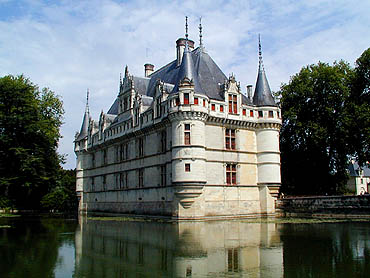
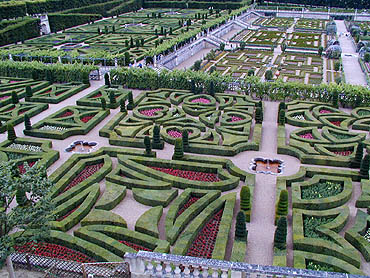
The moral to this story: The French do speak English, even if they know just a few words. If you show them courtesy, they will reward you with charm and smiles. We encountered the France of fairytales, romance, art and poetry. So shut your ears to the horror stories of others, and endeavor to write your own happy endings!